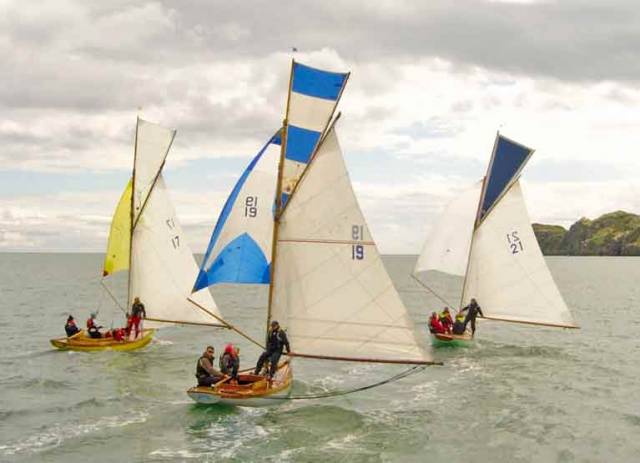The Massey family’s 1907-built Deilginis of Howth Yacht Club has retained the Howth Seventeen Annual Championship after a five–race series concluded on Saturday with a countback following a points tie with the 1910-built Oona (Peter Courtney) writes W M Nixon.
The combined age of the boats taking part in this well-supported event was 1,487 years. And though this oldest active keelboat class in the world has a strong presence of younger sailors in its makeup of crews, the fact that many boats now find they do best four up meant that the total combined ages involved with people and boats soared through the 2,000 years mark.
But in mostly ideal conditions, Race Officer Neil Murphy was able to get in a complete programme which would have been envied by many younger classes, thanks to putting through a preliminary race on Friday evening, sailed in sunshine and a brisk southwest to west breeze.
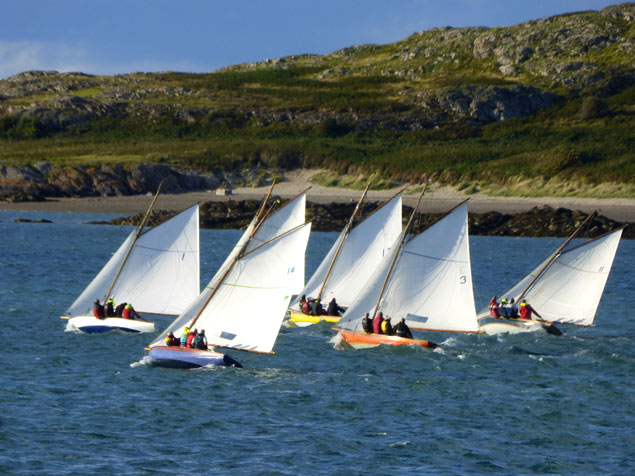 The Friday evening race in a brisk sou’west to west breeze sent the Howth Seventeens away from a traditional pier start through the Sound inside Ireland’s Eye. Photo: W M Nixon
The Friday evening race in a brisk sou’west to west breeze sent the Howth Seventeens away from a traditional pier start through the Sound inside Ireland’s Eye. Photo: W M Nixon
Although Conor Turvey helming the 1988-built Isobel had the best of the start, by the finish Luke Massey had brought Deilginis through to the lead, and at the line it was Deiliginis, Oona and Roddy Cooper’s 1898-built Leila taking the honours.
However, the real excitement was back in the midst of the fleet, where Transatlantic Solo Race winner Conor Fogerty was guest helming aboard the Lynch family’s Echo. In a close encounter on a rolling run with Eileen, the latter’s mainsail came in across the Lynch boat, and their star visiting helm found himself wrapped up in Eileen’s mainsheet, and hauled into the sea.
Any talk of being Lynched was reckoned in the worst possible taste as they got the right people aboard the right boats. And nothing daunted, the Atlantic veteran raced on despite being soaked to the skin, though the 14th place recorded by Echo became her discard.
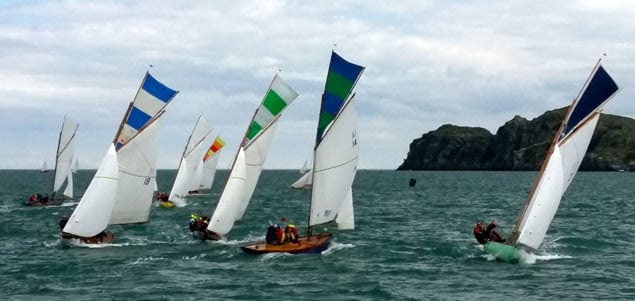 Saturday at first brought plenty of breeze, but topsails were carried throughout. Photo: Neil Murphy
Saturday at first brought plenty of breeze, but topsails were carried throughout. Photo: Neil Murphy
Things were back to normal in the morning, and Saturday’s packed programme was staged in a west to nor’west breeze which was marginal for topsails at first, but with the forecast for wind strengths to ease as the day went on, the fleet went forth with full sail set.
It was intriguing to note the different levels of skills being shown in the arcane arts of setting a jackyard tops’l. The fact that Peter Courtney’s family have been involved with the class since 1907 suggests that it’s an inherited talent, as the topsail on Oona was in place to perfection, setting as one with the mainsail, whereas some other boats had inefficiently large gaps between the jackyard and the gaff.
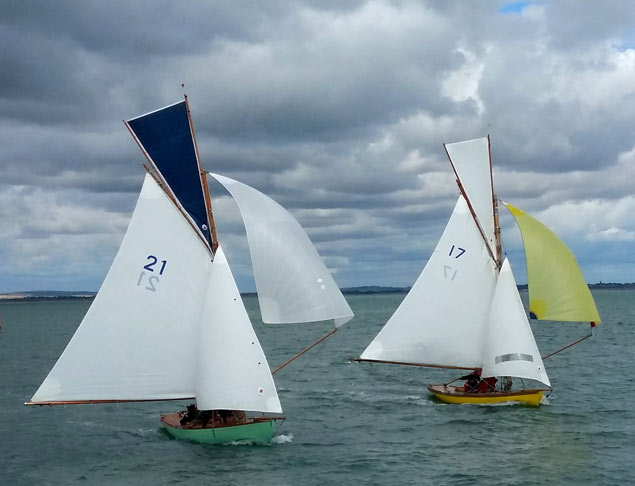 The new French-built Orla (Ian Malcolm, left) and Peter Courtney’s Oona, which had the best-set topsail in the fleet. Photo: Neil Murphy
The new French-built Orla (Ian Malcolm, left) and Peter Courtney’s Oona, which had the best-set topsail in the fleet. Photo: Neil Murphy
Despite the style of her topsail setting, Oona was back in third in Saturday’s first race, but Deilginis was on a roll with another win. However, the Courtney boat then moved rapidly up the ranking with two firsts in Saturday’s second and third races, while Deilginis logged a sixth and a second. This meant they were head to head in the final race with Deiliginis in cover on Oona, while the brand-new French-built Orla (Ian Malcolm) read a windshift to perfection to take the win, with second going to the Turveys and Isobel, and Deilginis and Oona coming in third and fourth.
With them tied on 7.0pts after discards, the quick judgment was that Oona must have it, as she discarded a fourth while Deilginis dropped a sixth, and they both had a scoreline of two firsts, a second and a third. But somewhere in the deepest depths of World Sailing Rules it apparently says that in the event of a tie, the placings in the final race are the decider, with discards ignored, so Deilginis retained the title she won in 2016, with Oona second, Isobel third and the new Orla fourth on a 4th, 5th, 6th and 1st, with an 11th discarded.
In a class of this size, the availability of handicaps adds greatly to the commitment of the fleet, and the placings in this division were 1st Gladys (Pat Heydon), 2nd Bobolink (Doyle/Finnegan/Walsh), 3rd Silver Moon (Susan Morgan) and 4th Erica (Ian Byrne and Eddie Ferris).
 The breeze eased on Saturday as the day went on, but the full programme was completed. Under the rules of the class, it is obligatory to carry the entire spinnaker on the weather side. Photo: Neil Murphy
The breeze eased on Saturday as the day went on, but the full programme was completed. Under the rules of the class, it is obligatory to carry the entire spinnaker on the weather side. Photo: Neil Murphy
As to a Howth championship being won by “the Dalkey boat”, it goes back into the mists of time, when Dublin Bay Sailing Club were casting about around 1906, looking for a seaworthy little keelboat class. Having searched high and low, it was pointed out to them that a well-proven little class was hidden round on the other side of Howth Head. Apparently they were called the Howth Seventeens, and the word was they did the business as regards seaworthiness and good racing.
So in classic Kingstown style, Dublin Bay Sailing Club adopted the design, immediately renamed them the Dublin Bay Seventeen, and ordered seven to be built by James Kelly in Portrush on the north coast, for delivery to Kingstown on flatbed railway trucks in time for the 1907 season.
Leading this movement was Dr W M A Wright who was to become DBSC Commodore in 1919. But in 1907, to underline the Dublin Bay character of his new Seventeen footer, he called her Deilginis, after that place which has been known as Dalkey ever since the Vikings passed through.
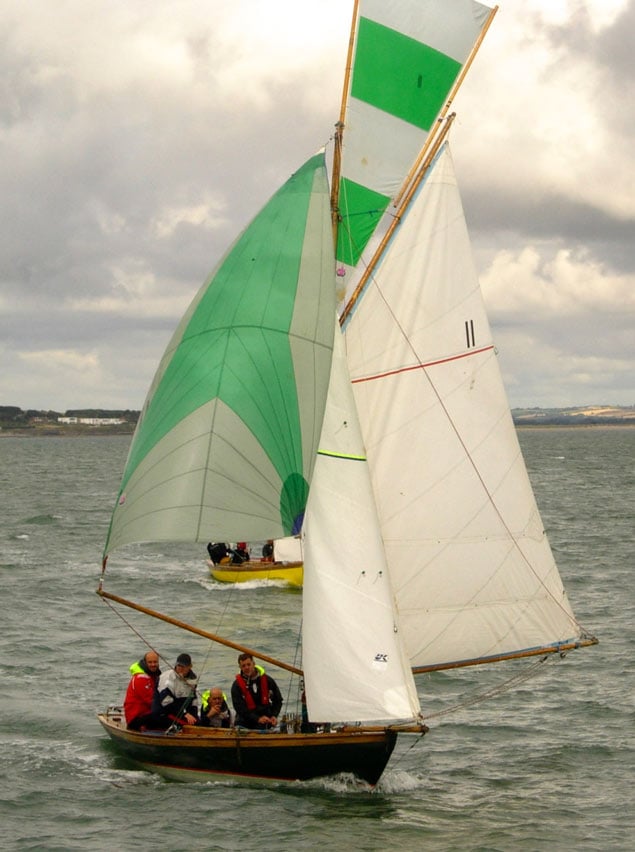 The Massey family’s 1907-built Deilginis, Howth 17 Champion 2017, was retrieved from the canal bank in Dolphin’s Barn in Dublin in a tarred and derelict state in 1971. Photo: Neil Murphy
The Massey family’s 1907-built Deilginis, Howth 17 Champion 2017, was retrieved from the canal bank in Dolphin’s Barn in Dublin in a tarred and derelict state in 1971. Photo: Neil Murphy
Deilginis was a star of the Dun Laoghaire yachting scene for years, but by 1970 when Nick Massey was in the heart of the movement to re-locate all the boats to Howth, the word was that Deilginis was in a state of dereliction, with evidence of tar being deployed, on the banks of the Grand Canal at Dolphin’s Barn in Dublin.
We just don’t have the space, time or knowledge to explain how Dolphin’s Barn got its name. Sufficient to say that Nick and his siblings and shipmates managed to retrieve what was left of Deilginis around 1970, and her path has been onwards and upwards ever since, with this past weekend yet another waypoint on that magic route.


























